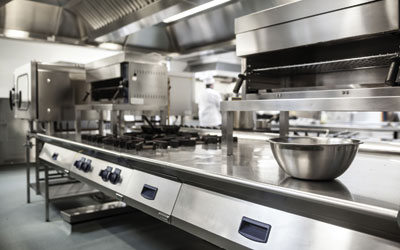The ENERGY STAR difference
Posted: 9 December 2015 | Kirsten Hesla, Commercial Food Service Programme Manager, EPA’s ENERGY STAR Programme | No comments yet
Commercial kitchens are extremely energy intensive. These establishments encompass everything from restaurants and bars, to school kitchens and hotels, to high volume quick-service restaurants. They can consume between 5-7 times more energy per square foot than other commercial buildings. The Environmental Protection Agency’s (EPA) ENERGY STAR programme estimates that a single commercial kitchen appliance consumes more energy than an entire home; the annual energy consumption of a standard electric deep fat fryer is more than an average U.S. household’s electricity use for a whole year!


By outfitting a commercial kitchen with a suite of ENERGY STAR certified commercial food service equipment, operators could save nearly $5,000 a year on energy costs and reduce greenhouse gas emissions by about 42,000 pounds annually.
Equipment that earns the ENERGY STAR label is typically built better than conventional models, resulting in reduced maintenance costs and down time. The rising costs of utilities and ongoing maintenance costs greatly outweigh the initial purchase price of a piece of equipment. Making energy-efficient choices when it is time to upgrade or replace commercial kitchen equipment can help reduce utility bills, and make significant contributions to a cleaner environment. Many energy utilities also offer rebates for ENERGY STAR certified commercial food service equipment. More than 100 utilities across the United States offer incentives for commercial kitchen equipment. ENERGY STAR maintains a searchable database of current product rebates from utility companies and other energy-efficiency program sponsors.
New ENERGY STAR specifications for commercial kitchen equipment
Across more than 70 product categories, ENERGY STAR products are independently certified to meet strict specifications for efficiency and performance. These products use less energy, save money, and help protect the environment. The programme covers a broad range of commercial kitchen products including commercial dishwashers, fryers, griddles, hot food holding cabinets, ice machines, ovens, refrigerators, freezers and steam cookers. In order to earn the label, manufacturers use high-quality components and innovative technologies that often lead to additional benefits, including: shorter cook times, higher production rates, and longer product lifetimes.
EPA continuously monitors the commercial kitchen equipment market and updates ENERGY STAR programme requirements or adds new categories when the opportunity arises to deliver more or new benefits to consumers and the environment. In May 2015, EPA announced plans to revise the current ENERGY STAR specification for commercial ovens, expanding the scope to include rack ovens. Currently, the ENERGY STAR label can be found on both convection and combination ovens. Commercial ovens that have earned the ENERGY STAR are approximately 20% more energy efficient than standard models.
Commercial coffee brewers were recently identified as a candidate for the ENERGY STAR programme, based on the potential energy savings in that category and their wide distribution. Preliminary test results indicate that some commercial coffee brewers could achieve up to 40% idle energy savings with improved insulation. An ENERGY STAR specification for commercial coffee brewers is currently under development and will be available for public comment in autumn 2015.
The ENERGY STAR Emerging Technology Award
The ENERGY STAR Emerging Technology Award was created to raise the profile of innovative technologies that may not yet meet key principles associated with the ENERGY STAR programme, but have the potential to significantly reduce greenhouse gas emissions once they are more widely adopted. The Emerging Technology Award is another way the ENERGY STAR programme promotes new and forward-thinking technologies that offer significant energy savings.
While most energy consumption in commercial kitchens is dominated by cooking – heating, ventilation, and air conditioning (HVAC) systems also require a lot of energy. In addition to the eight product categories ENERGY STAR covers within the Commercial Food Service Program, EPA has recognised Demand Control Kitchen Ventilation (DCKV) with the ENERGY STAR Emerging Technology Award for 2015.
Commercial kitchen ventilation removes excess heat and fumes generated during cooking. Inefficient or poorly designed exhaust systems allow heat and smoke to build-up in a kitchen. This is bad for indoor air quality and can lead to uncomfortable working conditions. Ventilation is necessary to ensure the comfort and safety of the kitchen staff, and minimises unpleasant cooking odors. DCKV optimises the ventilation system by modulating the fan speed to account for the increased or decreased cooking activity. Traditional ventilation systems run at maximum capacity throughout a kitchen’s operating hours, or only provide operators manual control over two speeds. To reduce energy consumption, DCKV provides automated fan speed control in response to temperature and other sensors that monitor cooking activity. DCKV technologies offer significant reductions in energy use and greenhouse gas emissions compared to standard kitchen ventilation systems. Food service facilities could see up to 60% energy savings by introducing this technology, depending on the facility and type of operation.
Tools and resources
In addition to designating equipment that reduces costs and energy consumption, the ENERGY STAR programme offers a range of tools to help operators stay smart about their energy use. Among the resources that operators will find on the ENERGY STAR web site (www.energystar.gov) are certified products lists, a rebate finder and calculators that estimate the amount of energy and water that qualified products save compared with conventional models.
Benchmarking and tracking the energy use in a commercial kitchen over time may bring to light new opportunities to reduce resource consumption. The ENERGY STAR Portfolio Manager allows commercial kitchen operators to track energy usage and compare their performance against that of other similar facilities. Portfolio manager can also be used to track the impact of conservation efforts over time
Contributing to a sustainable future
Overall, the interest in sustainability is gaining momentum amongst restaurant operators. According to the National Restaurant Association 2013 Restaurant Industry Forecast, nearly half of adults said they were likely to make a restaurant choice based on an operation’s energy and water conservation practices. Restaurant owners are responding; nearly 4/10 restaurant operators report using ENERGY STAR appliances in their facilities.
Water use is of increasing concern – many commercial food service products also use large amounts of water. Increased awareness of the need for water conservation and the cost associated with water usage are driving interest among food service operators in water saving opportunities. Many ENERGY STAR products also offer significant water savings. ENERGY STAR certified steam cookers can use 90% less water when compared with standard steam cooker models. An ENERGY STAR steam cooker uses an average of three gallons of water per hour, versus other standard models that can consume 40 gallons of water per hour. Commercial ice machines, in particular, consume valuable water resources during operation. ENERGY STAR commercial ice makers are on average 12% more energy efficient and 15 percent more water efficient than standard models. Installing an ENERGY STAR certified ice maker could save a commercial kitchen about 5,500 gallons of water annually. The technologies used to make them more efficient can also result in longer product lifetimes and faster ice production than standard machines.
The purchase and installation of ENERGY STAR certified products is only one component of successful kitchen energy management. Other significant factors include regular equipment maintenance, optimisation of operating schedules, and a focus on education – all of which must be considered as part of an overarching strategy. More information on best practices for maximising energy efficiency in food service operations can be found in EPA’s ‘ENERGY STAR Guide for Cafes, Restaurants, and Institutional Kitchens.’
ENERGY STAR encourages restaurants, commercial kitchen owners and operators to be creative about their energy management strategies and to remember that the opportunities for savings do not stop in the kitchen. In a typical restaurant, lights are usually on for 16 to 20 hours a day. There are nearly one million restaurants in the U.S. If each restaurant replaced one traditional light bulb with an ENERGY STAR certified bulb, the restaurant industry could save nearly $30 million annually and reduce greenhouse gas emissions by more than 450 million pounds.
Ultimately, the goal is for professional kitchens to be transformed into centres of sustainable practices, based on the increasing installation of equipment that is verifiably the most resource efficient. Reducing resource consumption at every phase of food service operations is the foundation of sustainability. It’s something the EPA and ENERGY STAR are proud to encourage. Leaving equipment on in idle mode wastes energy and money. ENERGY STAR encourages commercial kitchen operators to remember – when equipment is not in use, turn it off!
About ENERGY STAR
ENERGY STAR is a voluntary programme, that helps businesses and individuals save money and protect our climate through superior energy efficiency. Established in 1992, ENERGY STAR has been advancing the use of energy-efficient products and practices for over 20 years. ENERGY STAR indicates cost–effective, relevant, and high quality energy efficiency solutions, and more than 85% of Americans recognise the label.
For specific information on ENERGY STAR certified products for commercial food service, please see www.energystar.gov/cfs.
About the author
As the Commercial Food Service Programme Manager for EPA’s ENERGY STAR Programme, Kirsten works with leading manufacturers, retailers and efficiency programs to promote and advance the adoption of ENERGY STAR certified commercial food service equipment. Kirsten also leads the development of voluntary performance requirements for energy efficient commercial food service equipment. She has been with the U.S. Environmental Protection Agency since 2011, and holds both a Bachelor of Science and Master of Public Health degree from Emory University in Atlanta, GA.









